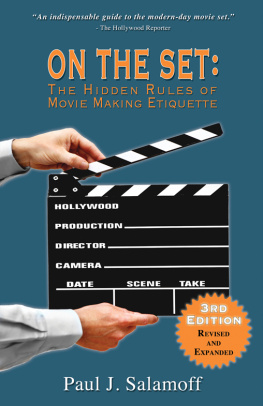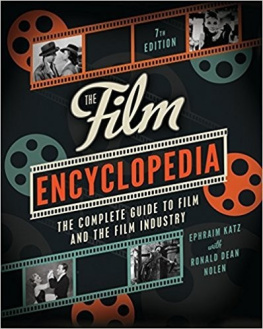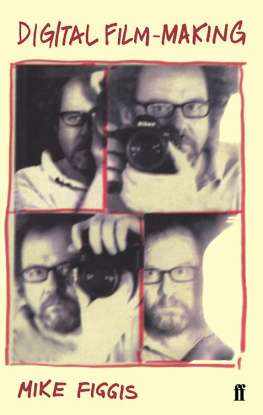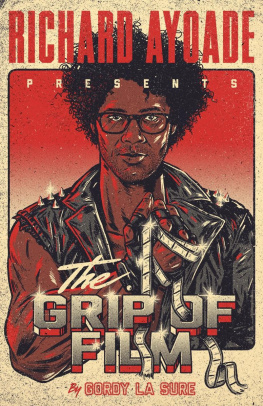
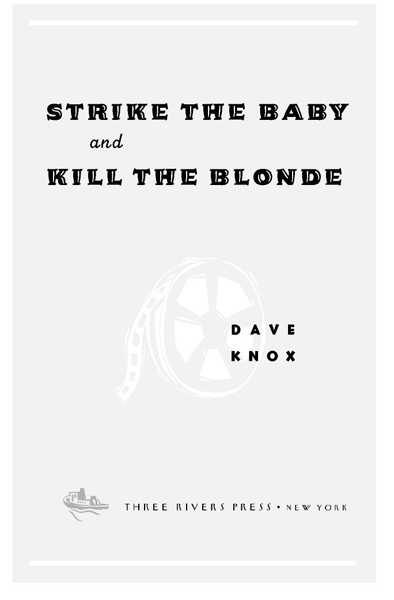
Table of Contents
FOR SARAH
Advance Praise for STRIKE THE BABY and KILL THE BLONDE
For every person who ever wondered just what, exactly, a grip really grips.... This comprehensive glossary of cinematic lingo is as much for the filmmaker as it is the filmgoer.
JANE ROSENTHAL, producer (Analyze That, Meet the Parents, About a Boy)
Dave Knoxs book is much more than a definition of film terms. It offers a dead-on look at the film business and life on a movie set, with an insight that is both authentic and funny.
ROBIN SQUIBB, script supervisor (Hitch, Analyze This, Die Hard III)
FO the double and gimme a lavender makes perfect sense to a grip but is impenetrable nonsense to the layman. Now with this lucid and amusing guide to the particular argot of the movie business, the outsider can begin to understand what it all means.
MICHAEL CHAPMAN, director of photography (Raging Bull, Taxi Driver, The Fugitive, Space Jam)
I only wish that this book had been written thirty years ago, when as an immigrant cameraman I landed in New York and tried to work in a new language. I was perplexed, and Strike the Baby would have provided some answers not found in standard dictionaries. Even today at dinner parties someone invariably asks, Whats a best boy? Read this book and find out!
ADAM HOLENDER, director of photography (Midnight Cowboy, Smoke, Fresh)
This book really hits the mark, and if you want to as well, you need to read it and find out how. Its very funny, perceptive, and most informative; it manages to cross those lines quite deftly.
ANDREW DUNN, director of photography (Sweet Home Alabama, Gosford Park, L.A. Story)
ACKNOWLEDGMENTS
Id like to thank all the people at Crown/Three Rivers Press, especially Orly Trieber, for publishing my book. My agent, Joanna Hurley, and the people at Hurley Media shepherded me all along the way. My friends Dave Whitford, Jim Meigs, and Andr Bernard offered encouragement and constructive criticism, while Pat Pruyne quickly solved all computer problems. My three readers, Becca Mudge, Rob Crandall, and Sarah Knox, kept me on the right track, offering timely edits as well as suggestions for fine-tuning the books humor. Many thanks. Having said that, any errors or misrepresentations are mine aloneI based the book totally on my own work experience, recollections, and attitudes.

INTRODUCTION
Go get me the two diving boards and the toilet seat for the camera dolly. This request came from the key grip (head rigging technician) on the set of the new Will Smith movie Hitch (aka The Last First Kiss), which we were filming in New York City, down in SoHo. Of course, I knew what George meant: He was going to affix extra platform space that would travel with the movie camera as I photographed the next shot. But to the layman? By using nicknames, he had identified specific equipment to the film crew and had disguised his meaning from passersby. Even a top-notch film student from New York University would have a hard time decoding his intentions. I began to think of all the confusing slang used every day on the movie set.
Go fetch me a show card! Fresh from college (where I received the aptly named B.S. in Speech from Northwestern University), on my first day on a real movie set, I didnt understand what was being asked of me. Well, my first day on a television commercial set, that is. In the past, I had supported myself as a commercial still photographer, and Id graduated from a premier film program, but this one was new to me. What is it, your first day? Actually, yes. How was I to know that a simple two-by-three-foot black-and-white piece of cheap cardboard was one of the primary tools of the professional filmmaker?
The director and cameraman of that Crisco commercial, Elbert Budin, strode past the line of cooked chicken pieces, over a thousand in all. That one, that one there, not that one. He was auditioning chicken pieces, all precooked and laid out on tabletops for the commercial spot. The assistant cameraperson rigged Elberts German-made movie camera for slow-motion filming, and the end of the day found me catching flying chicken pieces with my show card. We simply tossed the individual pieces of chicken into the air, and Elbert filmed them in slow motion on the way down, to demonstrate the idea that chicken cooked in Crisco was... lighter than air. I was hooked.
From there, it was a matter of gaining the technical skills with the camera equipment that would allow me to graduate from the ranks of chicken wrangler. I spent a year managing a film stage in Lower Manhattan, where I handled everything from painting sets to repairing lighting gear to walking the vicious guard dog. I was enamored of the large complicated movie cameras that came through the stage. Mitchell, Arriflex, Panavision... To me, these names meant HOLLYWOOD. Using my passkey on weekends, I was able to sneak back onto the stage and rifle through cases of expensive camera gear. With no one else around except for the trusty dog, El Capitn, I taught myself the technical intricacies of the different motion-picture camera systems. In the 1960s, the great German director Werner Herzog reportedly stole the camera he needed to make his first film, so my extracurricular activities put me in good company. The next year when the time came to take the test for admission to the union as assistant cameraperson, I passed with flying colors.
I worked as camera assistant on several films over the next two years, including manning an extra camera on the cult classic TheToxic Avenger, but once again something new and wonderful caught my eye. A screening of Francis Coppolas One from the Heart left me breathless. How did they photograph all those beautiful, intricate moving-camera shots? I had never seen anything like it. The Steadicam had been invented by Garrett Brown in 1973, and used on such high-profile films as Rocky and Saturday Night Fever, but was still seen by the industry as something rare and exotic. I contacted Brown and took one of the first weeklong training classes for camera operators dedicated to the Steadicam, a mobile camera system worn strapped to the operators body. Everything about the Steadicam appealed to me. It addressed all my interestscamerawork, choreography, precision, athletics. I borrowed some money and bought a beat-up Steadicam rig from the manufacturer, Cinema Products, practicing camera moves alone in my apartment with imaginary actors for months. A phone call: Garrett Brown had recommended me for a job on a feature film shooting in Pennsylvania. Was I ready?
We were lined up to begin filming on Marias Lovers, my first major Hollywood film as a camera operator. I was twenty-five years old and had grown a bushy red beard in an attempt to look a little older. Hopefully I could convince my coworkers that I was an experienced hand at this moviemaking stuff. The actors Nastassja Kinski and John Savage were in front of me, and I was standing next to the director with the Steadicam strapped to my back. The Russian director Andrei Konchalovsky wrapped a porcelain plate into a napkin. Suddenly he brought his foot down hard. Crash!
Next page

